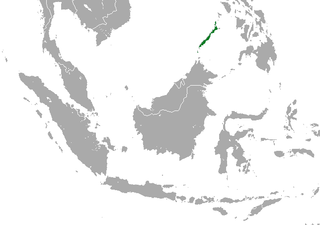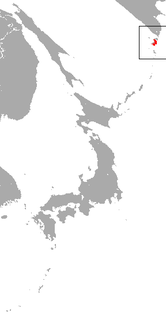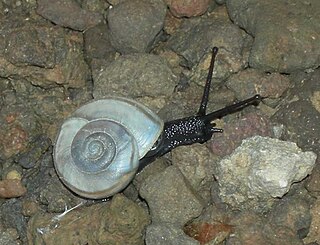
Artemisia tridentata, commonly called big sagebrush, Great Basin sagebrush or (locally) simply sagebrush, is an aromatic shrub from the family Asteraceae, which grows in arid and semi-arid conditions, throughout a range of cold desert, steppe, and mountain habitats in the Intermountain West of North America. The vernacular name "sagebrush" is also used for several related members of the genus Artemisia, such as California sagebrush.

The conservation status of a group of organisms indicates whether the group still exists and how likely the group is to become extinct in the near future. Many factors are taken into account when assessing conservation status: not simply the number of individuals remaining, but the overall increase or decrease in the population over time, breeding success rates, and known threats. Various systems of conservation status exist and are in use at international, multi-country, national and local levels as well as for consumer use.

The Mohave ground squirrel is a species of ground squirrel found only in the Mojave Desert in California. The squirrel was first described in 1886 by Frank Stephens of San Diego. It is listed as a threatened species under the California Endangered Species Act, but not under the federal Endangered Species Act. The IUCN lists this species as vulnerable.

A species that is extinct in the wild (EW) is one that has been categorized by the International Union for Conservation of Nature as known only by living members kept in captivity or as a naturalized population outside its historic range due to massive habitat loss.

Goldman's woodrat is a rodent species in the family Cricetidae. It is found only in Mexico throughout the Mexican Plateau, stretching from Southeast Chihuahua to South San Luis Potosi and North Queretaro. The plateau is an average 5,988 ft. above sea level and covers a land area of 232,388 sq. miles.

Villa's gray shrew is a shrew native to northeastern Mexico, where it is called musaraña.

The mountain shrike or grey-capped shrike, is a species of bird in the family Laniidae. It is endemic to the Philippines.
Nelson's kangaroo rat is a species of rodent in the family Heteromyidae which is endemic to the central plateau of Mexico.

The Somali hedgehog is a species of mammal in the family Erinaceidae. It is endemic to Somalia and Somaliland. The Somali hedgehog is nocturnal.

The Bornean water shrew is a species of mammal in the family Soricidae. It is endemic to Malaysia. Its natural habitat is rivers. It is threatened by habitat loss.

The Palawan shrew is a species of mammal in the family Soricidae. It is endemic to the Philippines and known from Palawan and Balabac Islands, from sea level to 1,300 m (4,300 ft) asl. It occurs in old growth and scrubby secondary forest. Habitat loss (deforestation) is a potential threat to this little known species, although it seems to tolerate habitat loss and modification.

The Ugandan lowland shrew is a species of mammal in the family Soricidae. It is found in Kenya and Uganda. Its natural habitats are subtropical or tropical swamps and subtropical or tropical moist montane forest. It is threatened by habitat loss.

Babault's mouse shrew is a species of mammal in the family Soricidae found in Burundi, the Democratic Republic of the Congo, and Uganda. Its natural habitat is subtropical or tropical moist montane forests. It is threatened by habitat loss.

The Paramushir shrew is a species of mammal in the family Soricidae. It is endemic to Russia. Its natural habitat is temperate forests. It is threatened by habitat loss.

Day's shrew is a species of mammal in the family Soricidae. It is endemic to India. Its natural habitat is subtropical or tropical dry forests. It is threatened by habitat loss.

The little Japanese horseshoe bat is a species of bat in the family Rhinolophidae. It is found in Japan and possibly China. Its natural habitat is temperate forests. It is threatened by habitat loss. It has not yet been assessed for the IUCN Red List.

Sonorella allynsmithi is a species of land snail in the family Helminthoglyptidae. It is native to Arizona in the United States.
The Uspallata chinchilla rat is a species of chinchilla rat in the family Abrocomidae native to Argentina. This species was identified in 2002, by Braun and Mares from the University of Oklahoma. Only a single specimen has been examined.

A vulnerable species is a species which has been categorized by the International Union for Conservation of Nature that is threatened with extinction unless the circumstances that are threatening its survival and reproduction improve.

Endangered species as classified by the International Union for Conservation of Nature (IUCN), are species which have been categorized as very likely to become extinct in the near future. On the IUCN Red List, endangered is the second most severe conservation status for wild populations in the IUCN's schema after Critically endangered (CR). In 2012, the IUCN Red List featured 3,079 animal and 2,655 plant species as endangered (EN) worldwide. The figures for 1998 were 1,102 and 1,197 respectively.
This page is based on this
Wikipedia article Text is available under the
CC BY-SA 4.0 license; additional terms may apply.
Images, videos and audio are available under their respective licenses.















